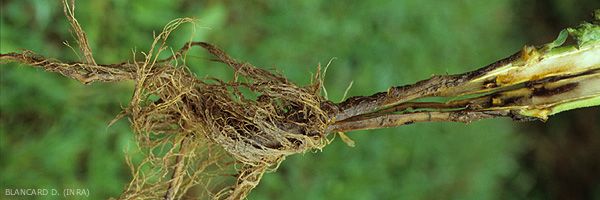
Oomycetes
Pythium spp. and Phytophthora spp.
Damping-off, Root-rot, Collar canker
- English names : damping-off, root-rot, collar canker, Pythium diseases
Several species of Pythium and Phytophthora are pathogens of tobacco. The species most frequently reported on tobacco are: Pythium ultimum Trow, P. aphanidermatum (Edson) Fitzp., P. debaryanum Hesse (syn. Pythium irregulare), P. butleri Subramaniam (syn. Pythium aphanidermatum), P. monospermum Pringsh., P. delienseMeurs, P. myriotylum Drechsler, P. splendens Braun, P. vexans de Bary, P. perniciosum Serbinow and Phytophthora nicotianae Breda de Haan (1896) (formerly Phytophthora parasitica var. nicotianae Tucker, 1931).
Pythium ultimum and Pythium aphanidermatum are the two most commonly reported species on tobacco. The first is rather prevalent in temperate regions, whereas the second is favoured by the warm conditions of the tropics.
We have described all the oomycetes at the same fact sheet, with the exception of Phytophthora nicotianae (please, see the corresponding fact sheet), because (a) the family of Chromista causes similar symptoms, (b) these micro-organisms are often influenced by the same environmental conditions and (c) the recommended control methods are identical.
Oomycetes are present in all countries of the world and occur wherever tobacco is grown. They cause considerable damage especially in nurseries where re-seeding is frequently recommended. Epidemics in fields and curing barns are also sometimes reported.
In France the nurseries are disinfected regularly, thus these soil pathogens are not a problem. The development of the float water production system will likely change the situation because nutrient solutions, where trays are floated, are a highly favourable environment for the development of aquatic pathogens (see Damping-off).





